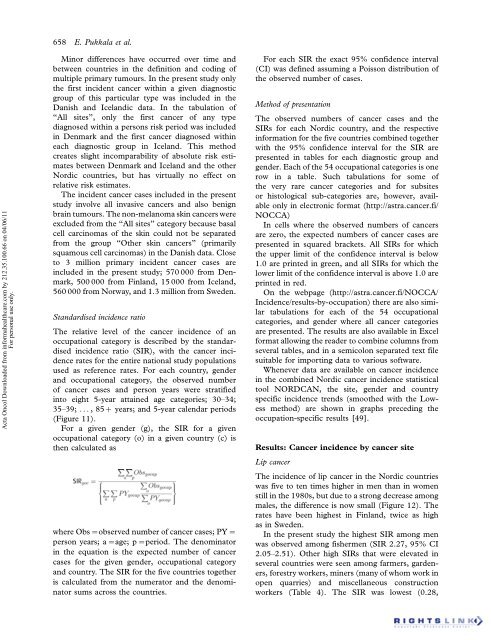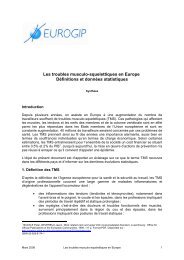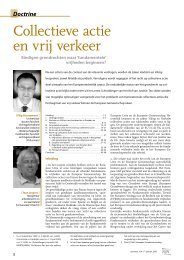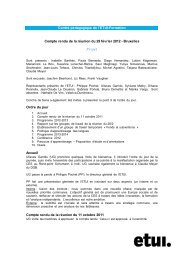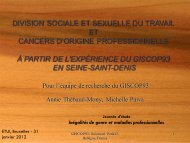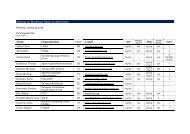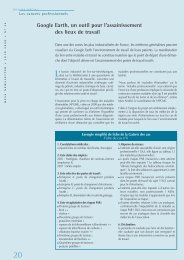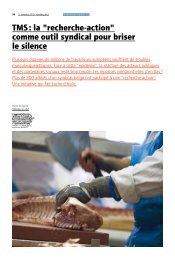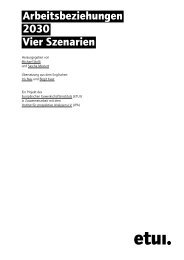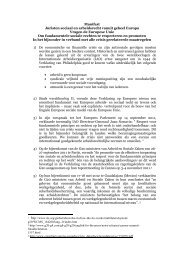Occupation and cancer - European Trade Union Institute (ETUI)
Occupation and cancer - European Trade Union Institute (ETUI)
Occupation and cancer - European Trade Union Institute (ETUI)
Create successful ePaper yourself
Turn your PDF publications into a flip-book with our unique Google optimized e-Paper software.
Acta Oncol Downloaded from informahealthcare.com by 212.35.100.66 on 04/06/11<br />
For personal use only.<br />
658 E. Pukkala et al.<br />
Minor differences have occurred over time <strong>and</strong><br />
between countries in the definition <strong>and</strong> coding of<br />
multiple primary tumours. In the present study only<br />
the first incident <strong>cancer</strong> within a given diagnostic<br />
group of this particular type was included in the<br />
Danish <strong>and</strong> Icel<strong>and</strong>ic data. In the tabulation of<br />
‘‘All sites’’, only the first <strong>cancer</strong> of any type<br />
diagnosed within a persons risk period was included<br />
in Denmark <strong>and</strong> the first <strong>cancer</strong> diagnosed within<br />
each diagnostic group in Icel<strong>and</strong>. This method<br />
creates slight incomparability of absolute risk estimates<br />
between Denmark <strong>and</strong> Icel<strong>and</strong> <strong>and</strong> the other<br />
Nordic countries, but has virtually no effect on<br />
relative risk estimates.<br />
The incident <strong>cancer</strong> cases included in the present<br />
study involve all invasive <strong>cancer</strong>s <strong>and</strong> also benign<br />
brain tumours. The non-melanoma skin <strong>cancer</strong>s were<br />
excluded from the ‘‘All sites’’ category because basal<br />
cell carcinomas of the skin could not be separated<br />
from the group ‘‘Other skin <strong>cancer</strong>s’’ (primarily<br />
squamous cell carcinomas) in the Danish data. Close<br />
to 3 million primary incident <strong>cancer</strong> cases are<br />
included in the present study; 570 000 from Denmark,<br />
500 000 from Finl<strong>and</strong>, 15 000 from Icel<strong>and</strong>,<br />
560 000 from Norway, <strong>and</strong> 1.3 million from Sweden.<br />
St<strong>and</strong>ardised incidence ratio<br />
The relative level of the <strong>cancer</strong> incidence of an<br />
occupational category is described by the st<strong>and</strong>ardised<br />
incidence ratio (SIR), with the <strong>cancer</strong> incidence<br />
rates for the entire national study populations<br />
used as reference rates. For each country, gender<br />
<strong>and</strong> occupational category, the observed number<br />
of <strong>cancer</strong> cases <strong>and</strong> person years were stratified<br />
into eight 5-year attained age categories; 30 34;<br />
35 39; ...,85 years; <strong>and</strong> 5-year calendar periods<br />
(Figure 11).<br />
For a given gender (g), the SIR for a given<br />
occupational category (o) in a given country (c) is<br />
then calculated as<br />
where Obs observed number of <strong>cancer</strong> cases; PY<br />
person years; a age; p period. The denominator<br />
in the equation is the expected number of <strong>cancer</strong><br />
cases for the given gender, occupational category<br />
<strong>and</strong> country. The SIR for the five countries together<br />
is calculated from the numerator <strong>and</strong> the denominator<br />
sums across the countries.<br />
For each SIR the exact 95% confidence interval<br />
(CI) was defined assuming a Poisson distribution of<br />
the observed number of cases.<br />
Method of presentation<br />
The observed numbers of <strong>cancer</strong> cases <strong>and</strong> the<br />
SIRs for each Nordic country, <strong>and</strong> the respective<br />
information for the five countries combined together<br />
with the 95% confidence interval for the SIR are<br />
presented in tables for each diagnostic group <strong>and</strong><br />
gender. Each of the 54 occupational categories is one<br />
row in a table. Such tabulations for some of<br />
the very rare <strong>cancer</strong> categories <strong>and</strong> for subsites<br />
or histological sub-categories are, however, available<br />
only in electronic format (http://astra.<strong>cancer</strong>.fi/<br />
NOCCA)<br />
In cells where the observed numbers of <strong>cancer</strong>s<br />
are zero, the expected numbers of <strong>cancer</strong> cases are<br />
presented in squared brackets. All SIRs for which<br />
the upper limit of the confidence interval is below<br />
1.0 are printed in green, <strong>and</strong> all SIRs for which the<br />
lower limit of the confidence interval is above 1.0 are<br />
printed in red.<br />
On the webpage (http://astra.<strong>cancer</strong>.fi/NOCCA/<br />
Incidence/results-by-occupation) there are also similar<br />
tabulations for each of the 54 occupational<br />
categories, <strong>and</strong> gender where all <strong>cancer</strong> categories<br />
are presented. The results are also available in Excel<br />
format allowing the reader to combine columns from<br />
several tables, <strong>and</strong> in a semicolon separated text file<br />
suitable for importing data to various software.<br />
Whenever data are available on <strong>cancer</strong> incidence<br />
in the combined Nordic <strong>cancer</strong> incidence statistical<br />
tool NORDCAN, the site, gender <strong>and</strong> country<br />
specific incidence trends (smoothed with the Lowess<br />
method) are shown in graphs preceding the<br />
occupation-specific results [49].<br />
Results: Cancer incidence by <strong>cancer</strong> site<br />
Lip <strong>cancer</strong><br />
The incidence of lip <strong>cancer</strong> in the Nordic countries<br />
was five to ten times higher in men than in women<br />
still in the 1980s, but due to a strong decrease among<br />
males, the difference is now small (Figure 12). The<br />
rates have been highest in Finl<strong>and</strong>, twice as high<br />
as in Sweden.<br />
In the present study the highest SIR among men<br />
was observed among fishermen (SIR 2.27, 95% CI<br />
2.05 2.51). Other high SIRs that were elevated in<br />
several countries were seen among farmers, gardeners,<br />
forestry workers, miners (many of whom work in<br />
open quarries) <strong>and</strong> miscellaneous construction<br />
workers (Table 4). The SIR was lowest (0.28,


